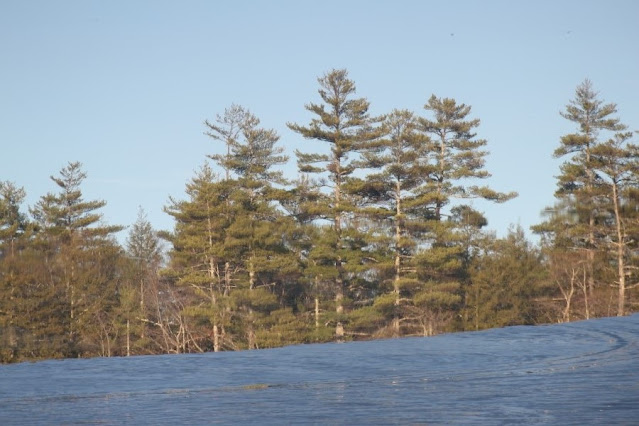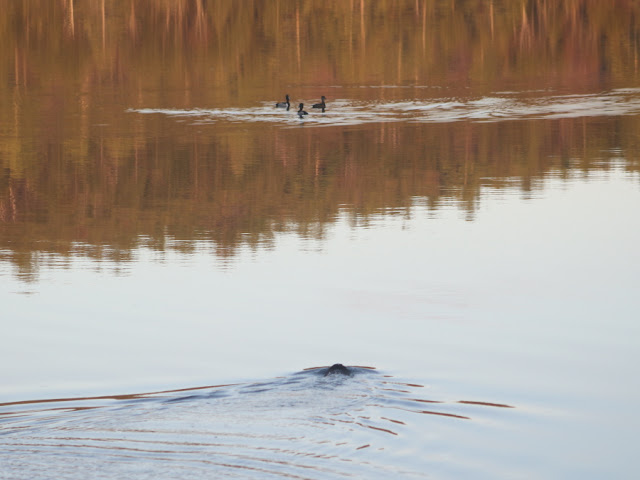It has been so windy this week there hasn't been much time on the water, but early in the week I had a nice paddle around the northern parts of Lake Wicwas including a trip up Blake Brook to the beaver dam. On my way across the center of the lake I was treated to an exciting acrobatic show being put on by a flock of tree swallows. These aerodynamic wonders are so quick and agile as they swoop overhead in pursuit of flying insects that it's hard to keep an eye on them, let alone take a picture.
 |
| The aerodynamic tree swallow (Tachycineta bicolor) |
But I floated for a long while in the middle of the lake on a beautiful spring day, content to just watch the show and click away almost randomly, hoping I'd catch something to share. I didn't count, but with probably close to a hundred pictures I managed a few that had a not-too-blurry bird in them.
Much of the time they spent swooping the surface of the water,
 |
| A perfect setting for DL for this tree swallow. |
but they would also soar high in the sky on occasion.
I wonder if they went up there to scout for bugs or just to enjoy the view.
Tree swallows are the first of the swallows to arrive each spring, both because they eat fruit in addition to the insects they collect, and also because they winter farther north than other swallows. They are not picky eaters, going after just about any insect they can find, and sometimes eating mollusks and worms. [Ref: Cornell Lab of Ornithology] During the breeding season they will also search out egg shells (goose, loon, egg shells from your compost pile - whatever they can find) for the calcium needed to produce their own eggs. [ibid]I believe their Latin name of bicolor comes from their varying iridescent green and blue colors depending on how the sun hits their feathers. Their common name comes from the fact that they nest in trees, usually in cavities that other animals such as woodpeckers have created (yet another reason to let dead trees stand in the forest). To create a comfortable nest for their young both parents will collect cast-off feathers from other birds to line the inside of the tree cavity.
Something else I learned from the Cornell Lab is their unusual bathing method: tree swallows will skim low over water, dipping their bodies into the water, then fly up, shaking off the water and any dirt it attracted from their feathers. Now that's something to watch for next time I see their air show over the lake!
Here's another example of artistry in nature - look at the perfect shape and symmetry of this bird's wing feathers.
I always think of one of Lake Wicwas' ardent nature-lovers when I see swallows hurtling through the sky ever since I learned that he loves these birds and watches for their return each summer!
Eventually I went on my way, continuing across the water, paddling up Blake Brook, a much easier task in early spring before the lily pads clog the way. As I neared the dam I thought someone was mowing with a tractor on the other side of the beaver pond as I heard the slow chug of diesel motor. I honestly looked across the lake trying to figure out where the machinery was, without success, until I realized it was within the dam itself. Water glugging through the dam was making the tractor sound! You can hear it chugging among the spring peepers and the scolding chick-a-dees that weren't happy with my presence here:
It reminded me of how Steamboat Springs, Colorado was named after a hot spring that made a thumping sound like a steamboat. How does "Tractor Brook" sound?
I couldn't see over the top of the dam but held up my camera and would guess that the beaver pond is one to two feet higher than the lake level.
That's a lot of impounded water to help get us through a dry summer, and perhaps a big factor in Wicwas maintaining its level during last summer's drought.
I neglected to mention last week that I saw my first trailing arbutus flower on April 17th, though I had a report of a sighting a couple of weeks earlier in a warm spot on the Sherman easement at the Page Pond Town Forest. (Thank you for the report JS!)
 |
| Trailing arbutus (epigaea repens), also known as mayflower - April 17 |
I'll end with this altered picture I took a couple of weeks ago, just hours before ice-out - see if you can detect how I modified it.
It looks a little strange doesn't it? It's upside down. Here it is in its proper orientation:










































